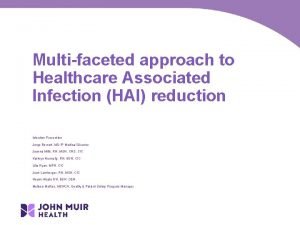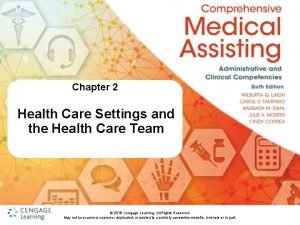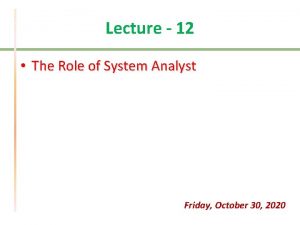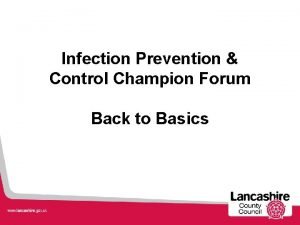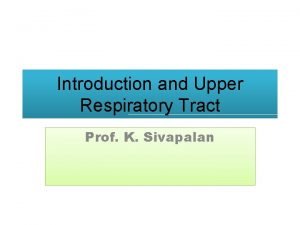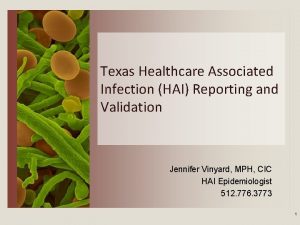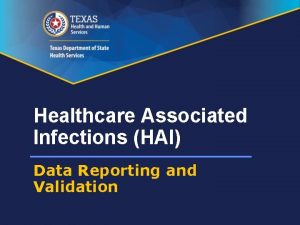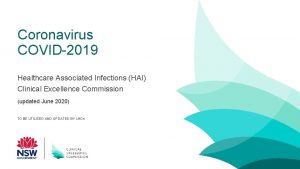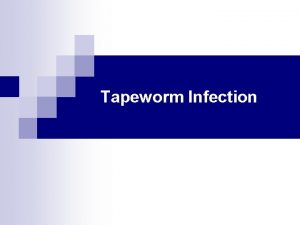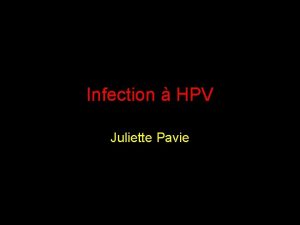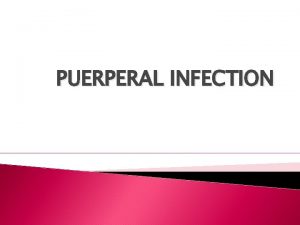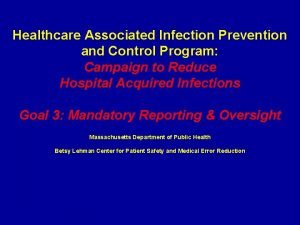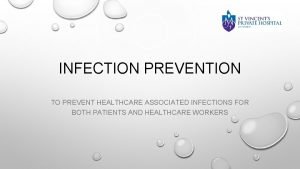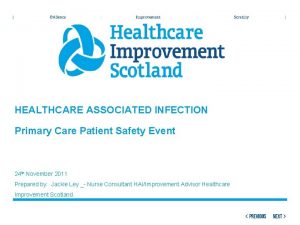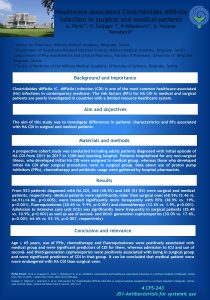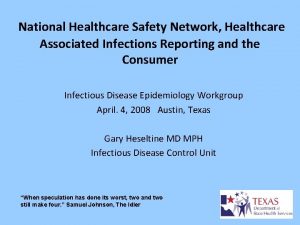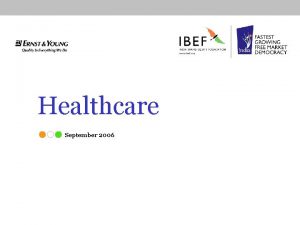Multifaceted approach to Healthcare Associated Infection HAI reduction

















- Slides: 17

Multi-faceted approach to Healthcare Associated Infection (HAI) reduction Infection Prevention Jorge Bernett, MD IP Medical Director Joanna Mills, RN, MSN, CNS, CIC Kathryn Nunnally, RN, BSN, CIC Lilia Ryan, MPH, CIC Jean Lemberger, RN, MSN, CIC Naomi Alcala RN, BSN , CEN Melissa Mc. Rae, MSHCA, Quality & Patient Safety Program Manager proprietary and confidential

Objectives • Describe methods utilized for device HAI reduction • Understand elements of CDI risk assessment and testing protocol • Identify components of a successful hand hygiene program proprietary and confidential 2

Background John Muir Health is a community based healthcare system comprised of two acute care hospitals with a combined total of 799 licensed beds and extensive clinic system in Contra Costa County CA. As of early 2016, John Muir Health (JMH) Medical Centers had sustained high rates of HAIs for a few years with little change despite various practice interventions. It became apparent that to address healthcare associated infections (HAIs) a variety of interventions must be employed in both prevention and reduction strategies. proprietary and confidential 3

Methods There were numerous efforts by multi-disciplinary teams that had an influence on improvement. The areas of focus that comprised the multifaceted approach included: • IP workflow, data analysis, physician engagement • HAI Improvement Team (Nursing) • CDI Task Force • Hand Hygiene Program proprietary and confidential 4

Methods: IP workflow, data analysis, physician engagement The Infection Prevention Department led by the Medical Director conducted in-depth analysis that identified opportunities, developed approaches and disseminated strategies to medical and nursing staff who in turn developed operational action plans. The IP practitioners streamlined their work flow to focus on rounding, staff engagement, education and participation in Quality nursing councils for trends, analysis and outcomes. They are responsible for the hand hygiene compliance data collection and coaching. proprietary and confidential 5

Methods: HAI Improvement Team (Nursing) • Nursing formalized a case review process that engaged bedside staff from all disciplines and empowered them to create the change necessary for improvement. o Developed case review forms o Conducted Case reviews, lead by bedside staff on the nursing units o Extended process to include collaborative coordinated structure which included nursing staff from both Walnut Creek and Concord Medical Centers o Expanded scope to include all HAIs • Identified obstacles to care, practice issues and implemented practice changes and actions o Standardized catheter care and timing o Developed bathing process with Theraworx, completed within 4 hours of a patient transferring from critical care or a stepdown unit to a medical/surgical unit to decrease chance that a bath would not occur for over 24 hours o Instituted patient hand hygiene standard o Updated Nurse driven catheter removal policy proprietary and confidential 6

Methods: CDI Task force The CDI task Force began in late 2015 after a review and recommendations from CDPH. In mid 2016 the team expanded membership and refocused efforts to address prompt identification of risk and testing. Utilizing evidence based guidelines, historical analysis trends and clinical case reviews, the team developed, trialed and implemented a testing algorithm that significantly improved outcomes. By the end of 2017 the rate of HO CDI decreased below the CMS baseline. Interventions included: o CDI Testing algorithm, prompt risk identification and testing o Focused and enhanced daily cleaning (New beach based product) o Patient and staff hand hygiene o EMR enhancements: documentation, orders and reports o Antibiotic Stewardship proprietary and confidential 7

Methods: Hand Hygiene Program The Hand Hygiene Program was reintroduced utilizing TJC TST (targeted solutions tool) developed to reduce variation in data quality. The program improved HH practice through standard work, refreshed education, team coaching, and a system of accountability from front line staff up through senior leadership. Implementation utilized a phased approach preceded by a pilot. o Infection prevention staff function as direct and open observers, collecting compliance data and coaching staff. o HH coaches were recruited from unit staff and trained to focused on collecting barrier data; the what and why. They also are responsible for coaching when non-compliance is observed, a major factor to create culture change. o Each department was responsible for Action Plans utilizing the barriers identified by unit coaches. proprietary and confidential 8

Results 2017 was a very positive year related to considerable improvement in HAI prevention and outcomes for both Medical Centers. Overall there was a 30% reduction in HAIs. The most significant improvement was in Clostridium Difficile Infection (CDI). Although there was a notable decrease in CAUTI, unfortunately there was not a reduction sufficient to reflect CMS SIR threshold. CLABSI results were also improved falling below the CMS SIR threshold. The dramatic success of the Hand Hygiene Program not only improved compliance from a baseline 51% to 89% but also served to focus on HAIs that had a direct and indirect impact on improvement. proprietary and confidential 9

Process: Improved Hand Hygiene compliance House-wide Baseline (11/2016 -12/2016) House-wide December, 2017 51% 89% WCMC and CMC Combined – Monthly HH Compliance 100% 89% 90% 84% 78% Goal = 80% 78% 83% 84% 78% 74% 70% 65% 61% 57% 60% 51% 50% ec D ov N ct O Se p Au g l Ju n Ju ay M r Ap ar M Fe b Ba se lin e 40% proprietary and confidential 10

Outcome: Successful HAI Reduction HAI Count (CAUTI, CLABSI, C. diff) versus Hand Hygiene Compliance 2017 WCMC & CMC 100% 90% HAI Count 20 80% 70% 15 60% 50% 10 40% 30% 5 Hand Hygiene Compliance (%) 25 20% Jan Feb Mar Apr May Jun Jul Aug Sep Oct Nov Dec 2017 HAIs per month Before: 19 2016 -2017 HAI Count Before and After Implementation • Measurement period at left: 1/2016 -12/2017 (2 years) HAIs per • HAI count reported is the median month • Hand Hygiene (HH) program implemented 1/2017 • Change (shift) in HH behavior occurred after 3/2017 After: • “Before” and “after” refer to the change that occurred 11 after 3/2017 proprietary and confidential 11

JMH Walnut Creek Medical Center Process Control CDI Testing Protocol EPIC Screening report BRU Tab Cleaning proprietary and confidential 12

JMH Concord Medical Center CDI Process Control Testing Protocol EPIC Screening report BRU Tab Cleaning proprietary and confidential 13

proprietary and confidential 14

proprietary and confidential 15

proprietary and confidential 16

Conclusions HAI improvement can be a difficult and labor intensive task. The causes and multifactorial nature of HAIs create a situation that can be daunting endeavor for any organization. Our experience with a multi-faceted approach has produced outcomes as intended. It was a collaborative effort dependent on Nursing, Physician, pharmacy, dietary, Environmental services and all ancillary staff to focus on attainable goals with the support and guidance of senior executives. Our work is certainly not completed but with this groundwork and culture we look forward to continue and sustained improvement. proprietary and confidential 17
 Multifaceted approach to health care
Multifaceted approach to health care Shabihe payambar hai hai ali akbar noha lyrics
Shabihe payambar hai hai ali akbar noha lyrics Healthcare and the healthcare team chapter 2
Healthcare and the healthcare team chapter 2 Sports medicine meaning
Sports medicine meaning Multifaceted role of system analyst
Multifaceted role of system analyst Evius
Evius Approach and landing accident reduction
Approach and landing accident reduction Deep learning approach and surface learning approach
Deep learning approach and surface learning approach Vc vs datagram
Vc vs datagram Bandura's reciprocal determinism
Bandura's reciprocal determinism Theoretical models of counseling
Theoretical models of counseling Research approach example
Research approach example Shower approach marketing
Shower approach marketing Traditional approach in system analysis and design
Traditional approach in system analysis and design Approach approach conflict
Approach approach conflict Infection control champion
Infection control champion Chapter 15:3 washing hands
Chapter 15:3 washing hands Broncheols
Broncheols
